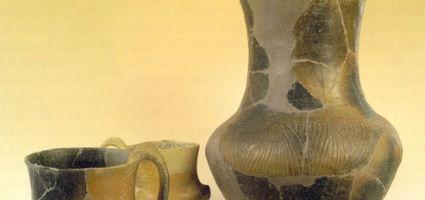2024. April 19. Friday
The Exhibition Titled '6000 Year Old Zók Culture' - Zók
 |
Address: 7671, Zók Arany János utca 13.
Phone number: (73) 472-297
E-mail: bicserdonkormanyzat@axelero.hu
Opening hours: On prior notice
|
Zók, a little village on the south of Transdanubia is 15 kilometers from Pécs. The first document on the village is from the 1290's. The hill called 'Castle Hill' yielded good soil for vine. It belonged to the village ever since the Middle Ages. The Archeological works uncovered a culture that lived there much earlier. The history of the Castle Hill is at least 6000 years old.
The Castle Hill is a peek between the Mecsek and the Mountains of Villány. Excavations have been performed since 1917 on the plateau. The findings close to the surface were mainly from the Bronze Age, they show a close relationship with the findings of Vucedol. The 'Zók' or the 'Vucedol-Zók' culture was named after the area.
The Croatian army performed the first excavations in 1919. The findings were taken to Beograd. Later only a few of the dishes were made public, on top of it there was no documentation of the excavations.
In 1943, the archeologist of the Museum of Pécs, Gyula Török supervised the excavations in Zók, but only on a restricted area. The systematic work started in 1977 to answer the questions raised in connection with Hungary and the early Bronze Age.
The earlier settlement found at the area is from the Copper Age (Lasinja-Balaton culture, 4 thousand years BC). Following this, the excavation of the Baden culture from the late Copper Age took place and the traces of the Vucedol-Zók culture surfaced. This settlement from the early Bronze Age, which existed for around 300 years, betrays a system of methodic organization. A defense ditch surrounded the buildings. The latest findings are in connection with the Somogyvár-¬Vinkovc culture. The scattered objects can be found all over the plateau. They are very different from the objects of the Vucedol-Zók culture.
Beside the findings of the Vucedol-Zók settlement, the most important findings are the items of metal industry of the early Bronze Age. The moulds, crucibles present the work of the local tradesmen. The abundance of the findings betrays a frequent commerce of raw material.
The clever use of the copper with arsenic led to a development of a new and higher society: the smiths. It also evoked the formation of the Smith Gods of mythology. The development of the Bronze Age in Europe can be traced by the findings of Zók.
István Ecsedy
The Castle Hill is a peek between the Mecsek and the Mountains of Villány. Excavations have been performed since 1917 on the plateau. The findings close to the surface were mainly from the Bronze Age, they show a close relationship with the findings of Vucedol. The 'Zók' or the 'Vucedol-Zók' culture was named after the area.
The Croatian army performed the first excavations in 1919. The findings were taken to Beograd. Later only a few of the dishes were made public, on top of it there was no documentation of the excavations.
In 1943, the archeologist of the Museum of Pécs, Gyula Török supervised the excavations in Zók, but only on a restricted area. The systematic work started in 1977 to answer the questions raised in connection with Hungary and the early Bronze Age.
The earlier settlement found at the area is from the Copper Age (Lasinja-Balaton culture, 4 thousand years BC). Following this, the excavation of the Baden culture from the late Copper Age took place and the traces of the Vucedol-Zók culture surfaced. This settlement from the early Bronze Age, which existed for around 300 years, betrays a system of methodic organization. A defense ditch surrounded the buildings. The latest findings are in connection with the Somogyvár-¬Vinkovc culture. The scattered objects can be found all over the plateau. They are very different from the objects of the Vucedol-Zók culture.
Beside the findings of the Vucedol-Zók settlement, the most important findings are the items of metal industry of the early Bronze Age. The moulds, crucibles present the work of the local tradesmen. The abundance of the findings betrays a frequent commerce of raw material.
The clever use of the copper with arsenic led to a development of a new and higher society: the smiths. It also evoked the formation of the Smith Gods of mythology. The development of the Bronze Age in Europe can be traced by the findings of Zók.
István Ecsedy
Opening hours
On prior notice
Services
guided tour
In Hungarian
Entrance is free of charge
for everybody
Contact
| Address | 7671 Zók, Arany János utca 13. |
| Telephone | (73) 472-297
|
| Fax | 472-299
|
| Web |